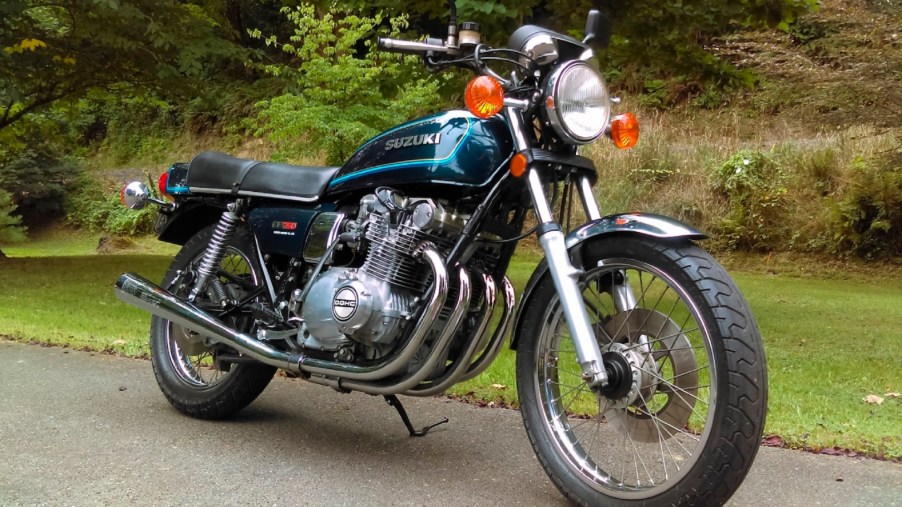
The Suzuki GS750 Is a Refined and Underrated Classic Bike
Modern bikes may have better technology, but it’s important to remember that what we call classic motorcycles were once cutting-edge machines. And even if bikes like the BMW K1 didn’t always sell well, they did at least introduce new features. But there’s something to be said about taking an idea and honing it. Such is the case with the Suzuki GS750.
The Suzuki GS750 didn’t improve on the UJM formula—it refined it

The Honda CB750 caused quite a stir when it launched in 1969. With a front disc brake, an electric starter, and a 750cc four-cylinder engine, it was the first superbike called as such. And its combination of good performance, ease of use, reliability, and overall style helped create a new segment: the Universal Japanese Motorcycle, Silodrome explains.

UJMs were the precursors to today’s standard motorcycles, Cycle World reports. And seeing Honda’s success with the CB750, other Japanese bike companies wanted in on the segment. The first rival was the 1973 903cc four-cylinder Kawasaki Z1, RideApart reports. And 3 years later, Suzuki responded with the GS750.
It’s worth keeping in mind that at the time of the Suzuki GS750’s release, the company was under significant pressure. Remember, this is decades before the record-breaking Hayabusa. Suzuki was an expert in 2-stroke bikes, Motorcyclist reports, but emissions regulations meant such models soon wouldn’t be feasible. And its attempts with rotary engines didn’t pan out, Motorcyclist reports.

As a result, the 1976 Suzuki GS750 closely followed the established UJM formula, Motorcycle Classics reports. So closely, in fact, that Suzuki was accused of copying Kawasaki’s homework, especially in regards to its inline-4 engine’s design. In reality, nothing of the sort occurred; Suzuki was simply applying observations of its competitors to the GS750.
However, while the Suzuki GS750 didn’t break new technological ground, it did refine the UJM recipe, Cycle World reports. And as a result, compared to the CB750 and Z1, it’s arguably more modern-feeling, BikeExif reports.
The Suzuki GS750 is a classic bike still worth riding today
Initially, the Suzuki GS750’s 748cc inline-4 engine, linked to a 5-speed transmission, put out roughly 60 hp at the rear wheel, Rider reports. The later E models had more valves and higher compression, raising output to 65 hp. But more impressive than the “above-average power,” Motorcyclist reports, was the engine’s reliability and smoothness. And while the valve adjustment is made using old-fashioned shims, that also makes this classic bike’s maintenance relatively straightforward.

However, that wasn’t the single most impressive thing about the Suzuki GS750. That would be the handling. It has a stiffer and more rigid chassis than the Honda CB750 and the Kawasaki Z1, which helped the later GS1000 win the 1978 Daytona 200, Cycle World reports. The GS platform would go on to win two AMA Superbike Championships and serve as the basis for the NHRA’s Pro Stock drag racing class. And at the time, the Suzuki GS750 was “the best-handling of the large Japanese bikes,” Cycle World reports.
The Suzuki GS750 also had a few technological advantages over other UJMs. In 1977 it offered optional twin-disc front brakes, years before the CB750 did the same. They would become standard on the GS750E in 1980. The GS750 also has a gear indicator, a rare feature on a classic 70s bike, RideApart reports. Little wonder many consider it “one of the best [UJMs] of its era,” Mecum reports. And if you change the oil and run the bike regularly, it’s reliable enough for weekly commuting, Motorcycle Classics reports.
It’s more affordable than you might think
Suzuki sold the GS750 from 1976-1983 before replacing it with the first GSXR, Rider reports. And as a result of the positive reviews, it sold extremely well. However, while other classic bikes of the era like the Honda CB350 Four have appreciated in value, the GS750 has largely been overlooked.

As a result, a good-condition GS750 or GS1000 is noticeably more affordable. According to Hagerty, even a pristine GS750E is unlikely to cost much more than $3000-$4000. The only exceptions are ones with Yoshimura Racing parts, Bring a Trailer reports. Hideo ‘Pops’ Yoshimura was the one who prepped the Daytona-winning GS1000, Iron & Air reports. But even so, Suzuki’s rotary bike is more expensive than the GS models, BaT reports.
Follow more updates from MotorBiscuit on our Facebook page.


